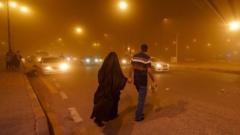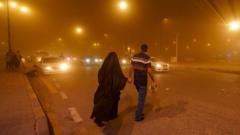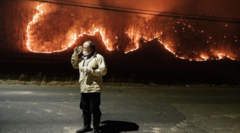A receding sandstorm in Iraq has highlighted the alarming rise in frequency and intensity of such weather phenomena, leading to public health emergencies and significant disruptions.
Sandstorm Engulfs Iraq, Causing Health Crises and Disruption

Sandstorm Engulfs Iraq, Causing Health Crises and Disruption
A severe sandstorm wreaks havoc across Iraq, showcasing increasing climate impacts.
A fierce sandstorm has swept through central and southern Iraq, blanketing the region in an eerie orange haze over the past two days. This weather event dramatically reduced visibility to less than half a mile in many areas, leading to the hospitalization of thousands suffering from respiratory issues. Authorities confirmed that two major airports halted all flights due to the hazardous conditions, and highways in Basra, the nation's southern hub, saw a stark decrease in traffic as high winds and swirling dust overwhelmed daily life.
Amir al-Jabri, spokesperson for Iraq's meteorology authority, reported that these "heavy waves of dust" originated from eastern Saudi Arabia, a mainly desert terrain, before accumulating debris from southwestern Iraq's parched landscapes. While sandstorms have been a seasonal occurrence during winter and early spring months, climate specialists warn that incidents such as these are on the rise, exacerbated by ongoing drought and progressive desertification engulfing previously fertile areas of both Iraq and neighboring Syria.
The recent storm has been identified as the most severe in Iraq for the year, following a similarly intense sandstorm that blanketed Baghdad in December 2025. Furthermore, the country, identified by the United Nations as the fifth most vulnerable to the ramifications of climate change, is facing increased challenges from extreme temperatures and dwindling water resources.
Despite a decrease in storm intensity, southern Iraq remains mired in sweltering temperatures that previously exceeded 100 degrees Fahrenheit. During the height of the storm, many residents resorted to wearing face masks, particularly those in service roles, while others used cloths to shield against the pervasive sand and dust that infiltrated homes and vehicles alike.
Iraq's health ministry indicated that hospitals throughout the southern region dealt with 3,747 cases of respiratory distress linked to the storm's impact. The most severely affected urban areas included Basra, with over a thousand patients recorded, and neighboring Najaf, where hundreds were also treated. Conditions were dire in Muthanna Province, close to the Saudi border, amplifying the public health crisis from the storm.
As measures to deal with ongoing sandstorms become urgent, local authorities circulated guidelines, including advice aimed at families, emphasizing how to comfort children disturbed by the storm's thunderous sounds. The continuous threat of such sandstorms underscores a pressing need for climate conversations and community preparedness in Iraq and the broader region.




















